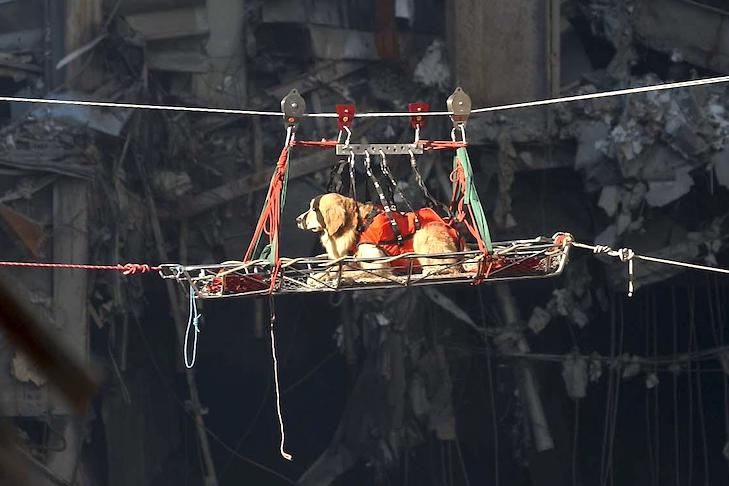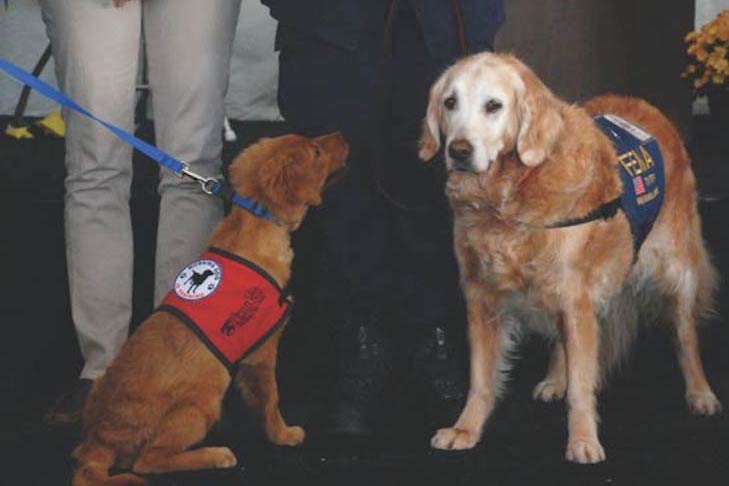
For days on end, for up to 12 hours a day, Bretagne, Willow, Lucy, and Sage exposed themselves to conditions that easily could have killed them. But these rescue dogs from 9/11 were just doing their jobs.
Bretagne, a 2-year-old Golden Retriever, Willow, a 5-year-old Labrador Retriever, and Lucy, a 10-year-old Border Collie, were among the many dogs that searched for victims after the attacks on the World Trade Center (WTC) on Sept. 11, 2001. Sage, a 2-year-old Border Collie, performed similar work at the Pentagon, which was attacked the same day.
Canine and Human Heroes
“Willow and I were one of four dog teams who deployed with the Pennsylvania Task Force,” recalls Willow’s handler, Bobbie Snyder, of Williamstown, New Jersey. “We searched the rubble in 12-hour shifts until they told us we were no longer needed.”
For all the Sept. 11 search-and-rescue (SAR) dogs, the work was dangerous and difficult. They climbed atop shifting piles of rubble. They sniffed deeply on the ground where toxic substances released from destroyed buildings were most highly concentrated. They allowed themselves to be lowered on swinging platforms to areas where human searchers couldn’t go.
The entire time, they worked in an environment full of ash and smoke. “It was hot, dangerous, and very dirty,” Snyder recalls. “But that is our job and we did the best we could.”
These 9/11 rescue dogs were working while surrounded by extremely stressed human beings. Denise Corliss, of Cypress, Texas, remembers how her canine partner interacted with the other rescuers. “Many of the rescuers I met on location would stop by to see Bretagne,” Corliss recalls. “While petting her [they] would tell me their stories about the loved ones who were missing. The stories were heartbreaking.”
Evaluating the Health of Rescue Dogs From 9/11
These dangerous, stressful conditions troubled Dr. Cynthia Otto. A veterinarian who was working at the WTC site, she had encountered dogs like Bretagne, Lucy, Sage, and Willow in the past. “I have been committed to providing medical support for these dogs to make the invaluable work that they perform as safe and effective as possible,” says Otto, director of the Penn Vet Working Dog Center at the University of Pennsylvania School of Veterinary Medicine.
After the attacks, Otto decided to monitor the SAR dogs deployed to the attack sites. She wanted to determine whether exposure to so many toxic substances would affect dogs’ long-term health — and perhaps gather clues about how these substances might affect human health. In the five years after 9/11, Otto and other investigators, with support from pet-care companies and groups such as the American Kennel Club Canine Health Foundation (AKC/CHF), did just that.

Otto was the principal investigator in the AKC/CHF-funded study in which she assessed dogs deployed to the World Trade Center, the nearby Fresh Kills Landfill (where some remains of the WTC victims were found), and the Pentagon. For comparison purposes, Otto also assessed SAR dogs that were not deployed to any of the three sites.
The study, which received corporate funding from the Veterinary Pet Insurance Company (VPI) and the Petco Foundation, required participating dogs’ handlers to complete questionnaires. These questionnaires gathered detailed information on the dog’s health care and medical histories. The handlers of deployed dogs also responded to questions about their dogs’ pre-deployment training, the lengths of their work shifts and rest periods, the number of finds they made, and their behavior both before and after their work at the attack sites. Many handlers periodically submitted samples of their dogs’ blood for analysis and allowed their dogs to be X-rayed. The study initially concluded in 2004, though it was extended for two more years.
A much smaller group of dogs participated in a study co-sponsored by the AKC/CHF and the Iams Company. From 2002 to 2006, these dogs underwent magnetic resonance imaging (MRI) to detect possible early signs of cancer and other health problems. It’s possible that health issues may have resulted from exposure to the hazardous materials, dust, and soot from the damaged or destroyed buildings. Iams provided the MRI services at its Pet Imaging Centers in Vienna, Virginia; Raleigh, North Carolina; and Redwood City, California.
The Caspary Institute of the Animal Medical Center in New York City conducted another study. Led by veterinarian Philip R. Fox and sponsored by AKC/CHF, VPI, the Petco Foundation, and Nestlé Purina, this study examined injuries and environmental hazards faced by the SAR and bomb-detection dogs of the New York City Police Department after the WTC attacks.
9/11 SAR Dogs: Examining Study Results
After four years of monitoring, the AKC/CHF-Iams study uncovered no signs of respiratory or nasal cancer in the 12 dogs studied, even though they received intense exposure to carcinogens and other toxic substances.
Bretagne, then 7, was one of the dogs being studied. “Bretagne had a series of health checks performed, and then we flew up [to Raleigh] for the MRI,” recalls Corliss. “She had shown no health problems, thank God.”

Five years of monitoring by Otto and her team yielded similar results. “We have not observed a significant difference in the incidence or nature of morbidity and mortality between the deployed dogs,” she says. Although the dogs did show some changes in blood values and evidence of exposure to toxins in the year that immediately followed the attacks, those changes — which were still within normal limits — resolved within two years.
Still, Otto takes nothing for granted. “Long-term effects could still manifest themselves as the dogs continue to age,” she points out. “So it is important that we remain vigilant as we monitor the health of these canines.”
Not all the dogs that began participating in Otto’s study in 2002 were still around in 2006. By 2006, 55 of the original 97 deployed dogs and 37 of the original 55 control dogs were still alive. Otto says that the difference in the overall mortality rates between the deployed dogs and control dogs is not statistically significant.
Many of the deployed dogs went to on to live happy and healthy lives. Lucy, age 15 in 2006, was already enjoying her retirement, according to handler Lynne Englebert, of Saratoga, California. Years of playing with flying discs and SAR work damaged the dog’s hips, and age diminished her sight and hearing. But “her nose works perfectly,” Englebert says. “For her 15th birthday party, she got to do a little search, a little tugging, and lots of fun with her friends.”
Current Findings
Bretagne was the last known surviving SAR dog deployed to a 9/11 site. She died on June 6, 2016, not long before she would have turned 17.
Otto has continued to evaluate the health of rescue dogs from 9/11. She looked at the causes of death of 95 SAR dogs deployed to 9/11-related sites (called exposed dogs). She then compared those results to the causes of death for 55 SAR dogs not sent to these particular places (called non-exposed dogs).
The latest research on the health of 9/11 rescue dogs found that both groups of SAR dogs lived for similar amounts of time (between 12 and 13 years). In both groups, degenerative diseases (like heart disease or osteoarthritis) were the most common causes of death, followed by cancer. The results held true, even when the researchers looked at various factors, such as dog’s age at deployment, breed, and blood results one year after being deployed.
Necropsies (which are autopsies for animals) were held for 63 dogs (44 exposed, 19 non-exposed). Out of the 63 dogs, 61 had similar amounts of anthracosis (when brown or black matter appears in a type of white blood cell located in the airway) in their lung tissue. So it appears that anthracosis is a concern for all SAR dogs, regardless of where they were deployed. Respiratory disease was rare for exposed and non-exposed dogs.
The scientists concluded that there was a low long-term health risk to rescue dogs from 9/11 after their deployment.
The AKC Gazette is the official journal of the sport of purebred dogs, and hasn’t missed an issue since 1889. Read the current AKC Gazette issue, sign up to receive new issues via e-mail, and browse 10 years of back issues on AKC.org.

